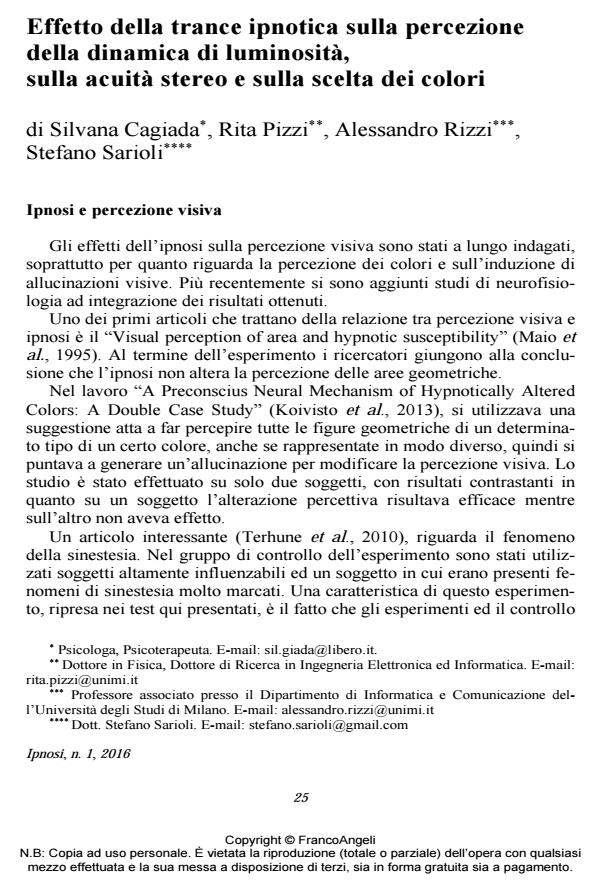Effetto della trance ipnotica sulla percezione della dinamica di luminosità, sulla acuità stereo e sulla scelta dei colori
Journal title IPNOSI
Author/s Silvana Cagiada, Rita Pizzi, Alessandro Rizzi, Stefano Sarioli
Publishing Year 2016 Issue 2016/1
Language Italian Pages 9 P. 25-33 File size 332 KB
DOI 10.3280/IPN2016-001003
DOI is like a bar code for intellectual property: to have more infomation
click here
Below, you can see the article first page
If you want to buy this article in PDF format, you can do it, following the instructions to buy download credits

FrancoAngeli is member of Publishers International Linking Association, Inc (PILA), a not-for-profit association which run the CrossRef service enabling links to and from online scholarly content.
In the presented experiment we have investigated the effects of hypnosis on the visual perception. In particular we have devised three tests to check the perception of luminance dynamic range, stereo acuity and color preference on the basic color set of Lüscher test. Results have proven no effect on stereo acuity but significant effects on the perception of luminance dynamic range and color preference. The perception of luminance dynamic range increase under hypnosis and the color preferences are largely modified.
Nella sperimentazione qui presentata sono stati indagati gli effetti dell’induzione ipnotica sulla percezione visiva. Nello specifico tre diversi esperimenti hanno testato l’effetto della trance ipnotica sulla percezione della dinamica di luminosità, sulla visione stereoscopica e sulla scelta del set base dei colori del test di Lüscher. I test hanno evidenziato un ampliamento significativo della dinamica percepita ed un cambiamento importante nella scelta dei colori, mentre non vi sono state modifiche significative nella percezione stereoscopica.
Keywords: Hypnosis, visual perception, luminance dynamic range perception, stereo acuity, Lüscher color test, Virtual theatre.
Silvana Cagiada, Rita Pizzi, Alessandro Rizzi, Stefano Sarioli, Effetto della trance ipnotica sulla percezione della dinamica di luminosità, sulla acuità stereo e sulla scelta dei colori in "IPNOSI" 1/2016, pp 25-33, DOI: 10.3280/IPN2016-001003